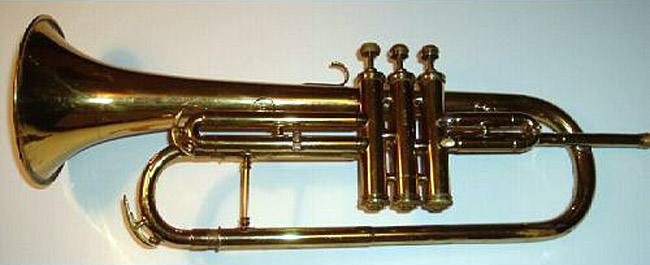Conn 20A The Fluegelhorn

Date: 1937. Owner unknown
The version of the 20A pictured here was in production from about 1927 to 1940. Notice that the main tuning slide is located where you would expect to find it in a trumpet. The usual place for the main tuning slide of a flugelhorn (these days, at least) is in the mouthpiece receiver. nterestingly, catalog D (1927~1928) shows this model 20A with the main tuning slide in the mouthpiece receiver and not where it is in the instrument pictured above. However, I have a picture of a 1928 20A Fluegelhorn with the main tuning slide as pictured here. Presumably either the mouthpiece receiver main tuning slide version was produced only very briefly, or the design was changed between the printing of catalog D and the actual production of instruments.
This model 20A was reinstated in 1963. See separate entry. As far as I can tell they are identical. That means they share the same bore size, 0.422" which is a #½. The bore expands through the main tuning.
I find that my 1969 20A is more of a cross between a cornet and a flugelhorn than a true flugelhorn. Since it is essentially the same instrument as this model 20A, I suspect the same holds true here. It is also brighter than a true flugelhorn. In that respect I suppose it could be called a "flurnet" (contraction of flugelhorn and cornet). Nevertheless, for me using my connstellation 5CW cornet mouthpiece I have a tone which while brighter than the average flugelhorn is acceptable for the purpose. If it is played in a section of flugelhorns as is customary in parts of northern Europe, it doesn't stand out. One should perhaps also keep in mind that when this model was designed by in the mid-1920's trumpets were, on average, quite a bit brighter than is the case at the moment with the trend being towards "darker" and larger bore sizes. That trend perhaps skews the average trumpet player's sound concept to making this flugelhorn seem brighter than it really is. Just a theory.
As far as I can tell at this point, all Conn cornets built before 1958 take a short shank cornet mouthpiece as opposed to the 2¾" "Bach-style" long shank cornet mouthpiece. The long shank cornet mouthpieces won't properly fit a pre-1958 Conn cornet and won't give the proper intonation or playing characteristics of a short shank cornet mouthpiece. All of Conn's "Connstellation" cornet mouthpieces are long shank mouthpieces. The "Improved Precision" Conn mouthpieces such as the Conn 4 are long shank if there is a "ridge" halfway down the shank, and short shank if there is no ridge (in which case it is a "Precision" mouthpiece). All Conn cornet mouthpieces built before the "Improved Precision" series (ridge), such as the "Precision" series (no ridge) are short shank mouthpieces. For more information see: The short and long of cornet mouthpieces
What Conn said in the 1930's:
Increasing recognition is being given to the fluegelhorn in American bands. Although built in Bb and A and of the same
voice as the cornet, the quality of tone is broader and more mellow. This tonal coloring is desirable for bridging the gap
between the cornets and the horns. Entirely new in design. Note the wide sweep of tubing, symmetry and balance. Built in
Bb and A, springs in bottom of Clickless Crysteel valves.